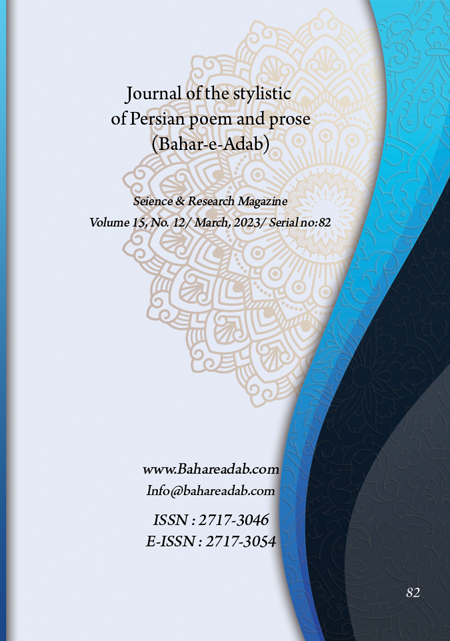- Count View : 383
- آدرس کوتاه شده مقاله: https://bahareadab.com/article_id/1417
- کد doi مقاله: Doi: 10.22034/bahareadab.2023 .15 .6803
Journal of the stylistic of Persian poem and prose
volume Number 15،
number In Volume 12،
،
issue Number 82
Examining the archetype of the veil in Saadi's works
Seyyed Mohammad Hossein Hasheminejad , Saeed Khairkhah (Author in Charge), Behruz Atoni
Abstract
BACKGROUND AND OBJECTIVES: Literature is one of the most original manifestations and the arena of emergence of unconscious and deep layers of the human psyche. "Mask" in application is a concept of Jung"s psychological terms, which from Jung"s point of view is actually that which is not a person; It is a representation of a personality that is not the same and equal to the person"s real self. Saadi"s works, as a part of literary masterpieces, are rooted in ancient beliefs and ideas and have benefited from the collective unconscious. The purpose of this essay is to show that Saadi"s works include a wide range of archetypal concepts and archetypes from the perspective of archetypal criticism. In this research, among the various archetypes, we will examine the veil archetype in Saadi"s works.
METHODOLOGY: The research method in this article will be descriptive-analytical based on library studies and psychoanalytical criticism based on the archetypal ideas of Carl Gustav Jung. Findings: By using myths, symbols and archetypes, Saadi"s works have a great ability to reflect the deep unconscious layers of the human psyche. Much earlier than psychologists such as Jung, Saadi has paid attention to archetypes such as the mask in his poems and writings, with the knowledge of the human psyche and subconscious mind.
FINDINGS: By using myths, symbols and archetypes, Saadi"s works have a great ability to reflect the deep unconscious layers of the human psyche. Much earlier than psychologists such as Jung, Saadi has paid attention to archetypes such as the mask in his poems and writings, with the knowledge of the human psyche and subconscious mind.
CONCLUSION: Based on the results of this research, in Saadi"s teachings, in line with Jung"s analytical psychology and the collective unconscious, the archetype of the mask can be seen in two positive and negative dimensions in Golestan and Bostan. The basis of Saadi"s teachings is that the way to perfection lies in true asceticism, piety, avoiding hypocrisy, arrogance, boasting, and observing moral standards. Saadi"s type of education can be seen based on the archetype of the niqab in the positive aspect, especially idealism and expediency, and the negative dimension of the niqab can be expressed in the distance from arrogance, pride, hypocrisy, etc.
Keyword
Saadi
, Jung
, archetype
, mask
, psychoanalytic criticism
- Blessed. Richard. (2009). Jung thought. Translated by Hussein Payende. Third edition. Tehran: Ashian, p.54.
- Bodkin. M. (1974). Archetypal patterns in poetry. London oxford university press.
- Dad. Sima. (2004). Dictionary of Literary Terms. Third edition. Tehran: Morvarid, p. 488.
- Fordham. Frida. (2009). An Introduction to Jungian Psychology. Tehran: Jami, p.80.
- Hall. Colin S. (2014). Theories of mental analysis (2); Jung Psychology Introduction. Translated by Shahriar Shahidi. Qom. Bright Future, p.48.
- Kamali Nahad. Ali Akbar and Bashiri. Zahra. (2014). "The mask and its effect in creating the poetic space of Mohammad Reza Shafiei Kadkani" Literary aesthetics. (20) 5, pp. 239-268.
- Mohammadi. Ali and Ismail Ali. Maryam. (2012). "A Comparative Study of the Archetype of the Neqab in Jung's Opinions and Its Traces in the Ghazals of Shams" Quarterly Journal of Mystical Literature and Mythology (26) 8, pp. 132-164.
- Najafi. Ali. (2011). "An Introduction to the Mask and Its Function in Contemporary Arabic Poetry" (1) 3, pp. 115-134.
- Palmer. Michael. (2006). Freud, Jung and Dean. Translated by Gholamreza Mahmoudi and Mohammad Dehganpour. Tehran: Roshd, p. 149.
- Parham. Mehdi and Ghaemi. Farzad. (2010). "Archetype of Pardisi city and its types and manifestations in Iranian culture and ancient Persian literature" Literary criticism studies (literary research). No. 17. pp. 151-170.
- qorbanipoor Aran. Hussein. (2010). "Sa’adi Mystical System in the Garden" Mystical Studies. No. 11. pp. 161-200.
- Robertson. Robin. (2015). Applied Jungology. Translated by Sarah Sargolzaei. Tehran: Culture of Life Foundation, pp. 40 and 45.
- Sa’adi, Mosleh al-din. (2008). Bustan. Corrected by Gholam Hossein Yousefi. Tehran: Kharazmi.
- Sa’adi. Mosleh al-din. (2010). Golestan. Correction and explanation: Gholam Hossein Yousefi. Third edition. Tehran: Kharazmi.
- Sa’adi. Mosleh al-din. (2013). koliyat Sa’adi. Edited by MohammadAli Foroughi. Third edition. Tehran: Hermes.
- Schultz. Devon and Sydney, Allen. (2011). Personality theories. Translated by Yahya Seyed Mohammadi. Tehran: virayesh, pp. 122-123.
- Shamisa. Sirus. (1997). The story of a soul. Tehran: Ferdows, p. 253.
- Shamloo. Sa’eed. (2003). Schools and theories in personality psychology. Tehran: Ferdows, p.52.
- Shayeganfar. Hamid Reza. (2001). Literary criticism; Introducing Critical Schools. Tehran: Dastan, p.138.
- Shaygan. Darius. (2002). Mental idols and eternal memory. Tehran: Amirkabir, p.208.
- Snowden. River. (2009). Jung Tutorial. Translated by Noureddin Rahmanian. Tehran: Ashian, pp. 53-54.
- Young. Carl Gustav. (1997). Psychology of the subconscious mind. Translated by Mohammad Ali Amiri. Tehran: Scientific and cultural.
- Young. Carl Gustav. (2009). Dream Analysis: Discourses on the Interpretation of Dreams. Translated by Reza Rezaei. Tehran: Afkar, p.13. 19.
- Young. Carl Gustav. (2012). The unknown self (the individual in today's society). Translated by Mahmoud Behforozi. Third edition. Tehran: Diba, pp. 17-18.
- Young. Carl Gustav. (2013). Man and his symbols. Translated by Mahmoud Soltanieh. Ninth edition. Tehran: Namad, pp. 29, 100.
- Young. Carl Gustav. (2014). Psychology and the East. Translated by Latif Sadghiani. Third edition. Tehran: Diba.
- Young. Carl Gustav. (2017). Psychology and religion. Translated by Fouad Rouhani. second edition. Tehran: Scientific and Cultural, pp. 12-15.

